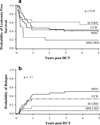Hematopoietic cell transplantation for children with acute lymphoblastic leukemia in second complete remission: similar outcomes in recipients of unrelated marrow and umbilical cord blood versus marrow from HLA matched sibling donors
- PMID: 19660721
- PMCID: PMC5225985
- DOI: 10.1016/j.bbmt.2009.05.005
Hematopoietic cell transplantation for children with acute lymphoblastic leukemia in second complete remission: similar outcomes in recipients of unrelated marrow and umbilical cord blood versus marrow from HLA matched sibling donors
Abstract
Transplant decisions for children with acute lymphoblastic leukemia (ALL) in second complete remission (CR2) are often based on the type of available donor. In many cases, allogeneic hematopoietic cell transplantation (HCT) is considered only if a human leukocyte antigen (HLA) matched sibling donor (MSD) is available. The role of unrelated donor (URD) HCT in this patient population is not well established. As advances in supportive care and donor selection have improved, the use of URD HCT in such patients should be reevaluated. We analyzed the outcomes of 87 consecutive children with ALL in CR2 who underwent allogeneic HCT at the University of Minnesota between 1990 and 2007. Donor sources included MSD bone marrow (n = 32), well and partially matched (M, n = 18) and mismatched (MM, n = 16) URD bone marrow and URD umbilical cord blood (UCB, n = 21). Although the incidence of neutrophil recovery was similar in all groups, the overall incidence of grades II-IV acute graft-versus-host disease (aGVHD) and chronic GVHD (cGVHD) was 37% and 9%, respectively, with a higher incidence of aGVHD in recipients of URD grafts. Leukemia-free survival (LFS) at 5 years was lower in recipients of MM-URD grafts, but was comparable in all other groups. Although relapse at 5 years was highest in recipients of MSD (50%), results were not significantly different compared to recipients of M-URD (17%), MM-URD (6%), and UCB (33%) (P = .17). The development of grades II-IV aGVHD and a first remission >3 years were associated with a lower risk of relapse (relative risk [RR] 0.2, P = .03; RR 0.2. P = .01 respectively). Together, these results support the continued investigation of URD HCT for ALL in CR2, and suggest the timing of HCT in these children should be based primarily on the risk of relapse with conventional chemotherapy and not on the type of donor available.
Figures

Similar articles
-
Allogeneic hematopoietic stem cell transplantation in adult acute lymphocytic leukemia: impact of donor source on survival.Biol Blood Marrow Transplant. 2008 Dec;14(12):1394-400. doi: 10.1016/j.bbmt.2008.09.021. Biol Blood Marrow Transplant. 2008. PMID: 19041062 Free PMC article.
-
Myeloablative hematopoietic cell transplantation for acute lymphoblastic leukemia: analysis of graft sources and long-term outcome.J Clin Oncol. 2009 Aug 1;27(22):3634-41. doi: 10.1200/JCO.2008.20.2960. Epub 2009 Jul 6. J Clin Oncol. 2009. PMID: 19581540 Free PMC article.
-
Outcome of haploidentical versus matched sibling donors in hematopoietic stem cell transplantation for adult patients with acute lymphoblastic leukemia: a study from the Acute Leukemia Working Party of the European Society for Blood and Marrow Transplantation.J Hematol Oncol. 2021 Apr 1;14(1):53. doi: 10.1186/s13045-021-01065-7. J Hematol Oncol. 2021. PMID: 33794963 Free PMC article.
-
Unrelated donor bone marrow transplantation for hematological malignancies-current status.Leuk Lymphoma. 1996 Oct;23(3-4):221-6. doi: 10.3109/10428199609054824. Leuk Lymphoma. 1996. PMID: 9031102 Review.
-
Which donor or graft source should you choose for the strongest GVL? Is there really any difference.Best Pract Res Clin Haematol. 2013 Sep;26(3):293-6. doi: 10.1016/j.beha.2013.10.010. Epub 2013 Oct 15. Best Pract Res Clin Haematol. 2013. PMID: 24309533 Free PMC article. Review.
Cited by
-
Cytomegalovirus-specific T cells are primed early after cord blood transplant but fail to control virus in vivo.Blood. 2013 Apr 4;121(14):2796-803. doi: 10.1182/blood-2012-09-453720. Epub 2013 Feb 14. Blood. 2013. PMID: 23412093 Free PMC article.
-
A single-center analysis of chronic graft-versus-host disease-free, relapse-free survival after alternative donor stem cell transplantation in children with hematological malignancies.Int J Hematol. 2017 May;105(5):676-685. doi: 10.1007/s12185-017-2189-1. Epub 2017 Feb 15. Int J Hematol. 2017. PMID: 28205066
-
Lower leukemia relapse in pediatric patients with pulmonary cytolytic thrombi following allogeneic transplant.Bone Marrow Transplant. 2011 Mar;46(3):368-71. doi: 10.1038/bmt.2010.119. Epub 2010 Jun 14. Bone Marrow Transplant. 2011. PMID: 20548337 Free PMC article.
-
Implication of early lymphocyte recovery after allogeneic hematopoietic stem cell transplantation in children with leukemia.Yonsei Med J. 2013 Jan 1;54(1):62-70. doi: 10.3349/ymj.2013.54.1.62. Yonsei Med J. 2013. PMID: 23225800 Free PMC article.
-
Comparison of outcomes after HLA-matched sibling and unrelated donor transplantation for children with high-risk acute lymphoblastic leukemia.Biol Blood Marrow Transplant. 2012 Aug;18(8):1204-10. doi: 10.1016/j.bbmt.2012.01.007. Epub 2012 Mar 6. Biol Blood Marrow Transplant. 2012. PMID: 22406037 Free PMC article.
References
-
- Harned T, Gaynon P. Relapsed acute lymphoblastic leukemia: current status and future opportunities. Curr Oncol Rep. 2008;10:453–458. - PubMed
-
- Gaynon PS. Childhood acute lymphoblastic leukaemia and relapse. Br J Haematol. 2005;131:579–587. - PubMed
-
- Boulad F, Steinherz P, Reyes B, et al. Allogeneic bone marrow transplantation versus chemotherapy for the treatment of childhood acute lymphoblastic leukemia in second remission: a single-institution study. J Clin Oncol. 1999;17:197–207. - PubMed
-
- Lawson SE, Harrison G, Richards S, et al. The UK experience in treating relapsed childhood acute lymphoblastic leukaemia: a report on the medical research council UKALLR1 study. Br J Haematol. 2000;108:531–543. - PubMed
-
- Barrett AJ, Horowitz MM, Pollock BH, et al. Bone marrow transplants from HLA-identical siblings as compared with chemotherapy for children with acute lymphoblastic leukemia in a second remission. N Engl J Med. 1994;331:1253–1258. - PubMed
Publication types
MeSH terms
Substances
Grants and funding
LinkOut - more resources
Full Text Sources
Other Literature Sources
Medical
Research Materials

